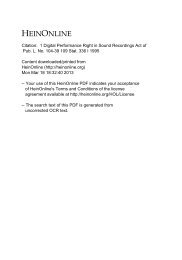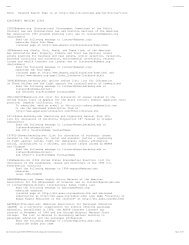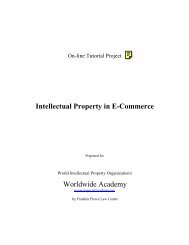BIEDERMANN MOTECH GMBH and Depuy Spine, Inc, Plaintiffs
BIEDERMANN MOTECH GMBH and Depuy Spine, Inc, Plaintiffs
BIEDERMANN MOTECH GMBH and Depuy Spine, Inc, Plaintiffs
Create successful ePaper yourself
Turn your PDF publications into a flip-book with our unique Google optimized e-Paper software.
Id. at 1373-74. The Federal Circuit held that the district court correctly construed the claim as written. Id. at<br />
1376.<br />
In the present case, the issue is as clear as in Chef America. The claim as written is unambiguous. The<br />
inventor's patent attorney used st<strong>and</strong>ard language of claim drafting language to claim something other than<br />
the preferred embodiment.<br />
The last question is whether there are any other problems with defining "holes" more broadly than "slits"<br />
without describing in the specification what these additional claimed embodiments might be. The areas of<br />
inquiry are indefiniteness, enablement, <strong>and</strong> written description.<br />
A claim is found invalid for being indefinite pursuant to 35 U.S.C. s. 112(2) "if, when read in light of the<br />
specification, it does not reasonably apprise those skilled in the art of the scope of the invention." Amgen,<br />
<strong>Inc</strong>. v. Hoechst Marion Roussel, <strong>Inc</strong>., 314 F.3d 1313, 1342 (Fed.Cir.2003). The term "holes" was defined<br />
above as "openings, which may be U-shaped slits, in the receiver member that receive a rod." The definition<br />
was made with the underst<strong>and</strong>ing that the term "holes" is more encompassing than the term "slits." Because<br />
the term "holes" was able to be defined, it is not indefinite. A claim is only indefinite if it is "insolubly<br />
ambiguous, <strong>and</strong> no narrowing construction can properly be adopted." Id.<br />
A claim is found to be invalid for lack of enablement pursuant to 35 U.S.C. s. 112(1) if the patent<br />
specification fails to teach a person of ordinary skill in the art how to make <strong>and</strong> use the invention without<br />
undue experimentation Id. at 1334. The preferred embodiment has a receiver member with two rodreceiving<br />
slits 12, 13 <strong>and</strong> two other slits 17 to facilitate the deformation of the receiver member when<br />
retaining nuts are applied. ('678 patent, col. 2 ll. 42-57; '678 patent, col. 3 ll. 47-56.) The preferred<br />
embodiment also has a compression member with two rod-receiving slits 20, 21 corresponding to the rodreceiving<br />
slits 12, 13 of the receiver member, <strong>and</strong> two other slits 23 are provided to allow deformation when<br />
retaining nuts are applied. ('678 patent, col. 3 ll. 5-13, 47-56.) If any of these slits are replaced with holes<br />
which are not slits, the question i s what that alternative embodiment would look like. Would a person of<br />
ordinary skill in the art be able to make <strong>and</strong> use such an alternative embodiment? The Court finds it difficult<br />
to imagine such an alternative embodiment, <strong>and</strong> the specification gives no guidance at all as to such<br />
modifications. However, "[t]he specification need not explicitly teach those in the art to make <strong>and</strong> use the<br />
invention; the [enablement] requirement is satisfied if, given what they already know, the specification<br />
teaches those in the art enough that they can make <strong>and</strong> use the invention without 'undue experimentation.' "<br />
Id. at 1334. As there is little evidence in the record regarding how a person of ordinary skill in the art would<br />
read the specification, at this point it would be premature to find claim 1 invalid for lack of enablement.<br />
A claim is found to be invalid for lack of written description pursuant to 35 U.S.C. s. 112(1) if the patent<br />
specification fails to recount his invention in such detail that his future claims can be determined to be<br />
encompassed within his original creation. Id. at 1330. The written description requirement is often more<br />
stringent than the enablement requirement. Id. at 1334. The "holes" limitation was not filed as part of the<br />
original application; rather, it was filed several months later. (Pl. Op. Br. at 9-10.) Thus, it must be carefully<br />
considered whether the "holes" limitation meets the written description requirement. Although it is<br />
somewhat unusual to discuss the written description requirement of 35 U.S.C. s. 112(1) in a claim<br />
construction motion, both parties have discussed the issue. (Allez Op. Br. at 10; Pl. Op. Br. at 10-11.) The<br />
Federal Circuit has on several occasions found that a patent is invalid on its face for lack of written<br />
description. See Univ. of Rochester v. G.D. Searle & Co., 358 F.3d 916, 927 (Fed.Cir.2004). This Court<br />
signaled its concern about written description in its previous Order, writing, "In any case, <strong>Depuy</strong> may have






